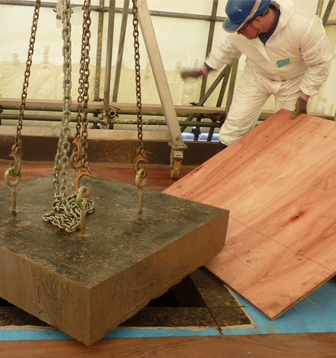
Water way to make the cut
Our diamond drilling experts in the North East were thrown in at the deep end to find a way of accessing a clean-water reservoir – without contaminating the water.
 A drilling expert was thrown in at the deep end to find a way of accessing a clean-water reservoir – without contaminating the water.
A drilling expert was thrown in at the deep end to find a way of accessing a clean-water reservoir – without contaminating the water.
John Emberson, the manager of D-Drill’s North East branch near Newcastle, was called in by a contractor to find a way of cutting an opening through a 200mm thick concrete roof of the tank at a Water Treatment Works in Northumbria.
The water company wanted to send down an exploratory submarine into the tank to investigate the water but it was vital that nothing else dropped in as a consequence of cutting the opening.
John said:
It had already been suggested that a stitch-drilling operation would be the best way to cut an opening into the tank. But once I assessed the job, I could see that there was too much of a risk that it could flake concrete from the underside of the slab and that would end up in the water. I decided that we could use a hydraulic hand-saw to cut down within 50mm of the full thickness and collect the slurry as we went along. Then the final cut would be made using a hydraulic ring saw because we could minimise any slurry due to the speed of cut. The main contractor put in place all water hygiene and cleanliness measures as well as the lifting equipment as the concrete slab was to be secured by an A-frame above the opening with chains and ‘lifting eyes’ fixed to the slab before any cutting took place.
But John needed to put his theory to the test to satisfy the water authority.
D-Drill carried out a trial run of the job on a different site but not in a live situation. The trial was undertaken under the watchful eyes of the water authority and its inspectors were very satisfied with the end result.
The main contractor, therefore, decided to employ D-Drill to carry out the cutting of three openings at the treatment works.
John drafted in two experienced engineers from D-Drill’s office in Sheffield, Darren Talbot and Graham Senior – who both hold Blue Clean Water industry safety cards, to carry out the live job.
As well as being extremely careful with regards to slurry, they had to also ensure that all tools and work ware was clean, while the hydraulic equipment was powered by biodegradable oil which is used in the food industry.
We were delighted with the end result. Obviously when you’ve seen the theory tested in a trial situation it gives you great confidence but, of course, you cannot rest until that has been followed through into the live job – which was undertaken in two stages. It was a testament to the expertise and professionalism of the team that we carried it through and that the main contractor and the water company were so happy with the result. It is always satisfying when you have to come up with a solution to a unique problem and it works so well.
Back to Projects